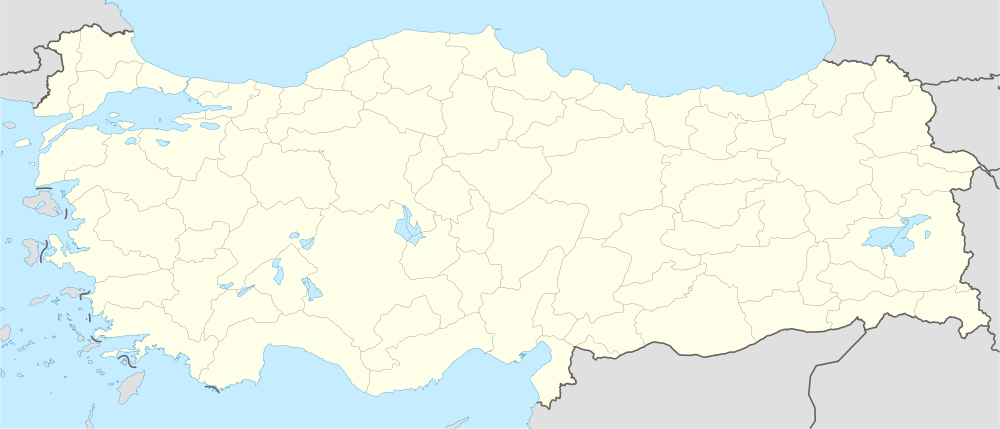Karatepe
| Karatepe | |
|---|---|
|
| |
 Shown within Turkey | |
| Location | Osmaniye Province, Turkey |
| Coordinates | 37°15′32″N 36°14′51″E / 37.258801°N 36.247601°ECoordinates: 37°15′32″N 36°14′51″E / 37.258801°N 36.247601°E |
| Type | Settlement |
| History | |
| Cultures | Hittite |
| Site notes | |
| Condition | In ruins |
Karatepe (Turkish for "Black Hill"; Hittite: Azatiwataya) is a late Hittite fortress and open-air museum in Osmaniye Province in southern Turkey lying at a distance of about 23 km from the district center of Kadirli. It is sited in the Taurus Mountains, on the right bank of the Ceyhan River. The site is contained within Karatepe-Arslantaş National Park.
History
The place was an ancient city of Cilicia, which controlled a passage from eastern Anatolia to the north Syrian plain. It became an important Neo-Hittite center after the collapse of the Hittite Empire in the late 12th century BCE. Relics found here include vast historic tablets, statues and ruins, even two monumental gates with reliefs on the sills depicting hunting and warring and a boat with oars; pillars of lions and sphinxes flank the gates.
Karatepe inscription
The site's eighth-century BCE bilingual inscription, in Phoenician and Hieroglyphic Luwian, reflects the activities of the kings of Adana from the "house of Mopsos", given in Hieroglyphic Luwian as Moxos and in Phoenician as Mopsos in the form mps. This inscription has served archaeologists as a Rosetta stone for deciphering Hieroglyphic Luwian. [1] [2] [3]
As we learn from the inscription, its author is Azatiwataya (or Azatiwata), the ruler of the town. He was also its founder; the inscription commemorates the town's foundation. He acknowledged himself as a subordinate of Awariku, the king of Adanawa (Adana), which was the ancient kingdom of Quwe. Azatiwataya seems to have been one of the frontier towns of Adanawa.[4]
Another inscription of the same type, the Cinekoy inscription, was discovered more recently. It also mentions king Awariku, who may have been the same ruler, or part of the same dynasty.
Troy theory
According to a 2010 ZDF documentary featuring the writer and translator Raoul Schrott, the fortress and surrounding landscape at Karatepe significantly match Homer's descriptions of Troy in the Iliad. According to this theory, Homer may have used his knowledge of the legend of Troy and combined it into historical fiction, using his own experiences and access to writings as a scribe in the service of the Assyrians in Karatepe.[5]
Archaeology
After the site was discovered in 1946, Karatepe was excavated from 1947 to 1957 by a team led by Helmuth Theodor Bossert, revealing the ruins of the walled city of king Azatiwataš. [6] [7] Restoration work was then carried on for many years, which included some further soundings. In the late 1990s, archaeological work, now led by Halet Çambel, was conducted on a palace at the site. [8]
Estimates for the dating of Azatiwataš rule have ranged from the early 8th century BCE to the early 7th century BCE. [9] [10] [11]
Recent usage
In the 2004 exploration of Mars, "Karatepe" was the name given to a site designated for entering the Endurance crater to investigate the layering of the bedrock.
Notes
- ↑ Cyrus H. Gordon, Azitawadd's Phoenician Inscription, Journal of Near Eastern Studies, vol. 8, No. 2, pp. 108-115, 1949
- ↑ R. D. Barnett, Karatepe, the Key to the Hittite Hieroglyphs, Anatolian Studies, vol. 3, pp. 53-95, 1953
- ↑ J. D. Hawkins and A. Morpurgo Davies, On the Problems of Karatepe: The Hieroglyphic Text, Anatolian Studies, vol. 28, pp. 103-119, 1978
- ↑ Trevor Bryce, The World of The Neo-Hittite Kingdoms: A Political and Military History. Oxford University Press, 2012 ISBN 0199218722
- ↑ http://www.zdf.de/ZDFmediathek/#/beitrag/video/951028/Der-Fall-Troia/
- ↑ Halet Çambel, Karatepe: An Archeological Introduction to a Recently Discovered Hittite Site in Southern Anatolia, Oriens, vol. 1, no. 2, pp. 147-162, 1948
- ↑ Helmuth Theodor Bossert, Karatepe kazilari (birinci ön-rapor) Die Ausgrabungen auf dem Karatepe (erster Vorbericht), Türk Tarih Kurumu Basimevi, 1950
- ↑ Halet Çambel and Asli Özyar, Karatepe-Aslantas, azatiwataya, die bildwerke, Verlag Philipp von Zabern, 2003, ISBN 3-8053-3085-5
- ↑ Irene J. Winter, On the Problems of Karatepe: The Reliefs and Their Context, Anatolian Studies, vol. 29, pp. 115-151, 1979
- ↑ David Ussishkin, The Date of the Neo-Hittite Enclosure in Karatepe, Anatolian Studies, vol. 19, pp. 121-137, 1969
- ↑ J. D. Hawkins and A. Morpurgo Davies, On the Problems of Karatepe: The Hieroglyphic Text, Anatolian Studies, vol. 28, pp. 103-119, 1978
References
- Halet Cambel, Corpus of Hieroglyphic Luwian Inscriptions, Vol. 2: Karatepe-Aslantas (Undersuchungen Zur Indogermanischen Sprachund Kulturwissenschaft, Vol 6), Walter de Gruyter, 1998 3-11-014870-6
- Julian. Obermann, New Discoveries at Karatepe. A Complete Text of the Phoenician Royal Inscription from Cilicia, Transactions of the Connecticut Academy of Arts and Sciences, Connecticut Academy of Arts and Sciences, vol. 38, 1948
- Benno Landsberger, Sam'al, Studien zur Entdeckung der Ruinenstaette Karatepe, Druckerei der Türkischen Historischen Gesellschaft, 1948
- Cyrus H. Gordon, Phoenician Inscriptions from Karatepe, The Jewish Quarterly Review, New Series, vol. 39, no. 1, pp. 41-50, 1948
See also
| Wikimedia Commons has media related to Karatepe. |
| ||||||||||||||||||||||||||||||